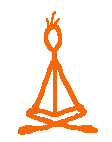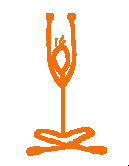LIVING MEDITATION
sitting
 |
Chants |
 |
Postures |
 |
Vows |
| HOME | SITTING | LIVING MEDITATIONS | US |
|
|
LIVING MEDITATIONsitting
|
'standing or walking, sitting or lying down, during all one's waking hours, let one practice the way with gratitude' ~Metta Sutta
 |
Hold for 5 to 10 breaths, relax and repeat.
 |
 |
Sit cross-legged with hands on knees. Focus on your breath. Keep your spine straight and push the sit bones down into the floor. Allow the knees to gently lower. If the knees rise above your hips, sit on a cushion or block. This will help support your back and hips. Take slow, deep breaths.
Possibly the most important posture, the Corpse, also known as the Sponge, is as deceptively simple as Tadasana, the Mountain pose. Usually performed at the end of a session, the goal is conscious relaxation. Many people find the "conscious" part the most difficult because it is very easy to drift off to sleep while doing Savasana. Begin by lying on your back, feet slightly apart, arms at your sides with palms facing up. Close your eyes and take several slow, deep breaths. Allow your body to sink into the ground. Try focusing on a specific part of the body and willing it to relax. For example, start with your feet, imagine the muscles and skin relaxing, letting go and slowly melting into the floor. From your feet, move on to your calves, thighs and so on up to your face and head. Then simply breathe and relax. Stay in the pose for at least 10-15 minutes.
YOGASITE.COMFor practicing Zen, a quiet room is suitable. Eat and drink moderately. Put aside all involvements and suspend all affairs. Do not think 'good' or 'bad'. Do not judge true or falso. Give up the operations of mind, intellect, and consciousness; stop measuring with thoughts, ideas, and views. Have no designs on becoming a Buddha. How could that be limited to sitting or lying down?
At your sitting place, spread out a thick mat and put a cushion on it. Sit either in the full-lotus or half-lotus position. In the full-lotus position, first place your right foot on your left thigh, then your left foot on your right thigh. In the half-lotus, simply place your left foot on your right thigh. Tie your robes loosely and arrange them neatly. Then place your right hand on your left leg and your left ahnd on your right palm, thumb-tips lightly touching. Straighten your body and sit upright, leaning neither left nor right, neither foward nor backward. Align your ears with your shoulders and your nose with your navel. Rest the tip of your tongue against the front of the roof of your mouth, with teeth and lips together both shut. Always keep your eyes open, and breathe softly through your nose.
Once you have adjusted your posture, take a breath and exhale fully, rock your body right and left, and settle into steady immovable sitting. Think of not thinking. Not thinking - what kind of thinking is that? Non-thinking. This is the essential art of zazen.
The zazen I speak of is not meditation practice. It is simply the Dharma gate of joyful ease, the practice-realization of totally culminated enlightenment. It is the koan realized, traps and snares can never reach it. If you grasp the point, you are like a dragon gaining the water, like a tiger taking to the mountains. For you must know that the true Dharma appears of itself, so that from the start dullness and distraction are struck aside.
When you arise from sitting, move slowly and quietly, calmly and deliberately. Do not rise suddenly or abruptly. In surveying the past, we find that transcendence of both mundane and sacred, and dying while either sitting or standing, have all depended entirely on the power of zazen.
Now I would like to talk about our zazen posture. When you sit in the full-lotus position, your left foot is on your right thigh, and your right foot is on your left thigh. When we cross our legs like this, even though we have a right leg and a left leg, they have become one. This position expresses the oneness of duality: not two, not one. This is the most important teaching: not two, and no one. If you think your body and mind are two, that is wrong; if you think that they are one, that is also wrong. Our body and mind are both two and one. We usually think that if something is not one, it is more than one; if it is not singular, it is plural. But in actual experience, our life is not only plural, but also singular. Each one of us is both dependent and independent.
The most important thing in taking the zazen posture is to keep your spine straight. Your ears and your shoulders should be on one line. Relax your shoulders, and push up towards the ceiling with the back of your head. And you should pull your chin in. When your chin is tilted up you have no strength in your posture; you are probably dreaming. Also to gain strength in your posture, press your diaphragm down towards your hara, or lower abdomen. This will help you maintain your physical and mental balance. When you try to keep this posture, at first you may find some difficulty breathing naturally, but when you get accustomed to it you will be able to breathe naturally and deeply.
Your hands should form the 'cosmic mudra'. If you put your left hand on top of your right, middle joints of your middle fingers together, and touch your thumbs lightly together (as if you held a piece of paper between them), your hands will make a beutiful oval. You should keep this universal mudra with great care, as if yo were holding something very precious in you rhand. Your hands should be held against your body, with your thumbs at about the height of your navel. Hold your arms freely and easily, and slightly away from your body, as if you held an egg under each arm without breaking it.
You should not be tilted sideways, backwards, or forwards. You should be sitting straight up as if you were supporting the sky with your head. This is not just form or breathing. It expresses the key point of Buddhism. It is a perfect expression of your Buddha nature. If you want true understanding of Buddhism, you should practice this way. These forms are not a means of obtaining the right state of mind. To take this posture itself is the purpose of our practice. When you have this posture, you have the right state of mind, so there is no need to try to attain some special state.